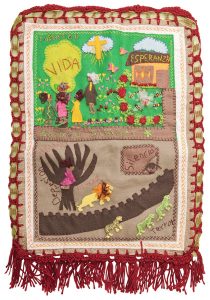 Hilos Resilientes Cosiendo Nuestras Historias
Hilos Resilientes Cosiendo Nuestras Historias
By Carolina Paz Gana & M. Lynne Jenkins
Sewing is traditionally women’s work. Often characterized as homespun, even quaint, it is associated with the domestic sphere. What at first glance may appear charming belies the persuasive ways in which women work with textiles to depict apartheid in South Africa, identity, forced migration, grassroots activism, encoded messages, and remembrance of murdered and missing indigenous women. Perhaps that is why the powers that be are mostly unaware of its subversive potential, and thankfully so, as this potential remains under the radar “sew” to speak while galvanizing those at the margins. How might sewing bring women together in a circle of care, give them a sense of belonging to a larger community that provides hope and meaning while creating the conditions for activism and social justice? Such gatherings of women allow for precisely the confluence of belonging, healing, and resistance.
Given their origins, we believe political arpilleras are particularly compelling in this regard. Arpilleras are three-dimensional appliquéd textiles of Latin America that originated in Chile. The backing is hessian, which translates into arpillera in Spanish. Women stitched onto hessian their everyday lived experiences under the gruesome and oppressive dictatorship of the US-backed coup of Augusto Pinochet, which occurred on September 11, 1973, against the democratically elected government of Salvador Allende. So, too, their threads and bits of fabric from the clothing of the “disappeared” allowed them to express what could not be expressed in words.
Continue to Article
